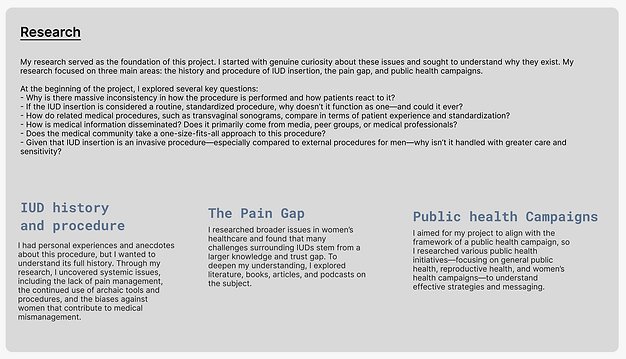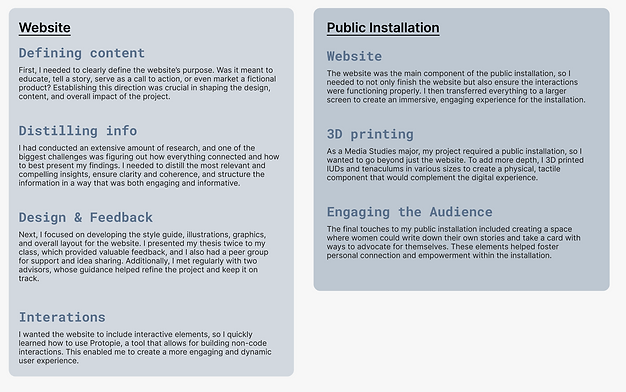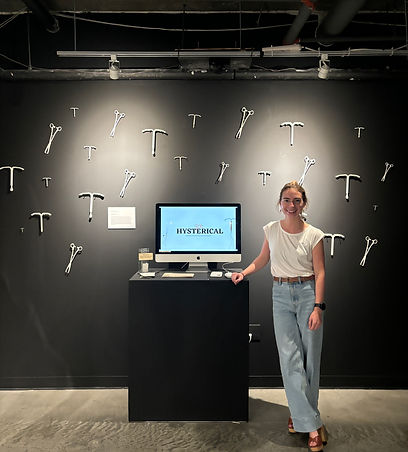Senior Thesis
Get Hysterical

Role
Media Studies Thesis Student
Tools
Protopie, Adobe Illustrator, Adobe Photoshop, Figma, TinkerCad, FLSUN-SR 3D printer
Skills
Storytelling, visual design, research, 3D printing
Timeline
January - May 2024
Introduction
We often place unquestionable trust in doctors due to their expertise, authority, and extensive education. While it is ingrained in us to believe that doctors possess all-encompassing knowledge and approach each situation with unbiased and good intentions, a critical examination of the medical system and its history reveals otherwise. Women, historically, have not been believed or taken seriously for their pain (known as the trust gap) and there has been a lack of knowledge about the female body (known as the knowledge) that have contribute to the flaws in reporoductive and more broadly women's healthcare. “Get Hysterical” explores the intersection of gender bias in healthcare and the experience of women seeking intrauterine devices (IUDs) in the United States.
Key Components
-
Research Paper: Researched a comprehensible of the "pain gap" which includes both the trust gap and the knowledge gap.
-
Interactive website: Designed an iteractive public health campaign website to inform audience of this topic and provide ways to advocate for themselves
-
Multi-media Installation: Delivered a polished design story and business model prototype. Presented insights, user-tested concepts, and actionable recommendations to Mimente, highlighting the path toward sustainable growth in the U.S. market.
Purpose
The project aims to shed light on the neglected needs of women in reproductive health. By unifying diverse stories and experiences, it seeks to communicate the complexity and pain associated with the IUD process. Here are some main whys of my project:
-
Advocacy for Women's Health: The project serves as a platform for advocating the prioritization of women's reproductive health. By delving into the specific challenges and disparities associated with the IUD experience, it seeks to draw attention to the broader issues faced by women in the realm of health.
-
Addressing Disparities in Pain Perception and Needs: Within the broader societal landscape, there exists a significant gap in the acknowledgment and response to women's pain and healthcare needs. The project aims to shed light on these disparities, emphasizing the importance of understanding and addressing the unique challenges faced by women in their reproductive health journeys.
-
Empowering Women's Narratives: By re-centering women in reproductive health narratives, the project aims to empower women to share their experiences authentically, and the unification that can come from sharing. This storytelling component is vital for fostering empathy, understanding, and solidarity among individuals who may not be fully aware of the challenges faced by women during procedures like IUD insertion.
-
Catalyzing Conversation: Through the mini-exhibit, encompassing research, artwork, and a human-centered redesign approach, the project endeavors to spark meaningful conversations. By bringing attention to the often overlooked aspects of women's reproductive health, it aspires to contribute to a paradigm shift in societal attitudes, medical practices, and even potential policy changes.
Research

The Process
I produced three main deliverables for this project: a paper, a website, and an installation. While they were interconnected and built upon each other, each followed a distinct process due to their different mediums. The paper followed a traditional progression from outline to rough draft, then through multiple revisions before reaching the final version. The website and installation, however, involved a more complex development process.

Website Design
This was a five-month research and design thesis, so I won’t go into every detail, but here are some key points:
- Design: I aimed for a serious, editorial look while incorporating informal handwriting to add a personal touch.
- Content: A mix of factual information and real remarks from women who have experienced the pain gap firsthand or undergone the IUD procedure.
- Format: The site starts with a focused look at the IUD and its procedure, then zooms out to the broader systemic issue, incorporating historical context to explain why the procedure remains the way it is today.
I first designed the website in Figma before transferring it to Protopie, a prototyping tool that enables interactive digital experiences.




Early Conceptions
There was a lot of trial and error to this project because I wasn't totally sure the most effective medium to convey my message. There were also all the rquirements I needed to have as a Media Studies thesis, there was time constraints, resource hurdles, ect. An example of one way I was thinking I wanted this project to go was to create an ironic fake campaign perpetuating some of the ridiculous, but true facts I was learning.
Verbal Anesthesia Pill Parody
A 2013 survey found that these “pain relievers” often fail to provide significant relief and there is currently no effective evidence-based strategy for managing pain in women who experience severe discomfort during [IUD] placement. Instead “verbal anesthesia” is suggested. Verbal anesthesia, or verbal relaxation therapy, is “the art of conversational distraction associated with measures to ensure a calming environment” and it's often used to prepare a patient for local anesthesia, not be used as a stand-alone pain management method. So the only way to “sufficiently” combat a procedure that 81% of women find to be moderate to insanely painful is for providers to say “the right thing at the right time”. Yes, that sounds as crazy as it verbally suggests.
So I wanted to create fake medication called anódynos, which was a pill that just had air in it. While I liked the creativity of this idea and marketing, I felt it strayed too much from the main topic of IUDs.

Exaggerated IUD
Another idea was to design an IUD (also named anódynos) that had ridiculous features, but I felt that it put too much criticism on the IUD and not the systemic problems I actually wanted to address. IUDs are an amazing birth control method and I didn't want to discourage the use or place blame on the technology of IUD.

3D Tenaculums and IUDs


Personal Reflections
I knew I had found a truly important topic. From a thesis perspective, I had struck gold—a subject that was personal, specific enough to be meaningful, yet connected to broader societal issues. The feedback I received from my classmates reinforced this:
-
"I appreciate how your work is rooted in research not only from the media studies field in regard to what you’re producing, but also the medical field. You’ve identified a specific area of focus, and I think your messaging will be more effective because of this."
-
"Thank you for highlighting this potentially taboo and stigmatized topic. As someone who has had an IUD and heard many horror stories from friends, I can definitely relate to this."
-
"This is an incredible project. I can’t wait to see all of this experimentation pay off in an awesome form. It’s clear that you have a strong passion for and significant knowledge on this topic. This interactive website will be incredibly impactful. Wow, this is so clever and very informative. The title is genius."
-
"This is such an important and undertalked-about topic, and I’m so glad you’re doing it! Thank you so much!"
The research phase felt like opening a can of worms. I was finally learning about issues I had personally experienced, but I thought were unique to me. As I dove deeper, I discovered shared experiences and a historical context that explained why these issues were so pervasive. It was both eye-opening and disappointing. The cold wake-up call was realizing how fundamentally flawed the American healthcare system is. Connecting all the dots was a challenge, but it ultimately made sense how these issues were intricately tied to the IUD procedure.
Along the way, I also came across groundbreaking human-centered design technologies that are revolutionizing the field. Two innovative companies are redesigning the speculum and tenaculum to make these tools less painful and more effective, offering a glimmer of hope for change in this space.
